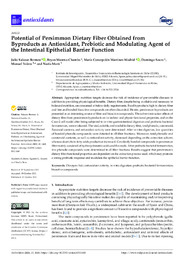Por favor, use este identificador para citar o enlazar este ítem:
https://hdl.handle.net/11000/35897Registro completo de metadatos
| Campo DC | Valor | Lengua/Idioma |
|---|---|---|
| dc.contributor.author | Salazar, Julio | - |
| dc.contributor.author | Moreno, Bryan | - |
| dc.contributor.author | MARTÍNEZ-MADRID, MARIA CONCEPCIÓN | - |
| dc.contributor.author | Saura, Domingo | - |
| dc.contributor.author | Valero Roche, Manuel | - |
| dc.contributor.author | Martí, Nuria | - |
| dc.contributor.other | Departamentos de la UMH::Agroquímica y Medio Ambiente | es_ES |
| dc.date.accessioned | 2025-03-10T16:29:01Z | - |
| dc.date.available | 2025-03-10T16:29:01Z | - |
| dc.date.created | 2021-10-22 | - |
| dc.identifier.citation | Antioxidants 2021, 10(11), 1668 | es_ES |
| dc.identifier.issn | 2076-3921 | - |
| dc.identifier.uri | https://hdl.handle.net/11000/35897 | - |
| dc.description.abstract | Appropriate nutrition targets decrease the risk of incidence of preventable diseases in addition to providing physiological benefits. Dietary fiber, despite being available and necessary in balanced nutrition, are consumed at below daily requirements. Food byproducts high in dietary fiber and free and bonded bioactive compounds are often discarded. Herein, persimmon byproducts are presented as an interesting source of fiber and bioactive compounds. The solvent extraction effects of dietary fiber from persimmon byproducts on its techno- and physio-functional properties, and on the Caco-2 cell model after being subjected to in vitro gastrointestinal digestion and probiotic bacterial fermentation, were evaluated. The total, soluble, and insoluble dietary fiber, total phenolic, carotenoid, flavonoid contents, and antioxidant activity were determined. After in vitro digestion, low quantities of bonded phenolic compounds were detected in all fiber fractions. Moreover, total phenolic and carotenoid contents, as well as antioxidant activity, decreased depending on the extraction solvent, whereas short chain fatty acids production increased. Covalently bonded compounds in persimmon fiber mainly consisted of hydroxycinnamic acids and flavanols. After probiotic bacterial fermentation, few phenolic compounds were determined in all fiber fractions. Results suggest that persimmon’s dietary fiber functional properties are dependent on the extraction process used, which may promote a strong probiotic response and modulate the epithelial barrier function | es_ES |
| dc.format | application/pdf | es_ES |
| dc.format.extent | 23 | es_ES |
| dc.language.iso | eng | es_ES |
| dc.publisher | MDPI | es_ES |
| dc.rights | info:eu-repo/semantics/openAccess | es_ES |
| dc.rights | Attribution-NonCommercial-NoDerivatives 4.0 Internacional | * |
| dc.rights.uri | http://creativecommons.org/licenses/by-nc-nd/4.0/ | * |
| dc.subject | Diospyros kaki | es_ES |
| dc.subject | Antioxidant activity | es_ES |
| dc.subject | In vitro digestion | es_ES |
| dc.subject | Probiotic bacterial fermentation | es_ES |
| dc.subject | Bioactive compounds | es_ES |
| dc.title | Potential of Persimmon Dietary Fiber Obtained from Byproducts as Antioxidant, Prebiotic and Modulating Agent of the Intestinal Epithelial Barrier Function | es_ES |
| dc.type | info:eu-repo/semantics/article | es_ES |
| dc.relation.publisherversion | https://doi.org/10.3390/antiox10111668 | es_ES |

Ver/Abrir:
2021_Potential of persimmon dietary fiber obtained from byproducts as antioxidant, prebiotic and modulating agent of the intestinal epithelial barrier function_2021.pdf
1,07 MB
Adobe PDF
Compartir:
 La licencia se describe como: Atribución-NonComercial-NoDerivada 4.0 Internacional.
La licencia se describe como: Atribución-NonComercial-NoDerivada 4.0 Internacional.
.png)